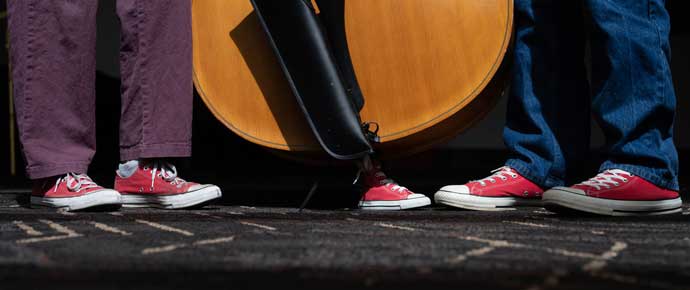Lucy Khadder and David Morris with their red Chucks at World of Bluegrass (9/28/22) – photo © Jeromie Stephens
Dr. Bobby Jones died 10 years ago. But his spirit lives on at IBMA’s World of Bluegrass, in the hearts of many attendees, as well as on my feet and on my bass.
I met Bobby, aka Tom Bibey, at IBMA in 2010, when we both reported for The Bluegrass Blog, predecessor of this publication. We looked forward to writing together again in 2011, but it was not to be. He was too weak to attend. As part of his physical therapy to relearn how to work, he wore a pair of red Chuck Taylor hightop Converse, which he called his “dancing shoes.” So I and several other friends wore them in his honor that year at IBMA.
And the following year, after he passed, I wore them in his memory. I’ve been wearing them ever since when I play, at IBMA or elsewhere. And somewhere along the way my upright bass started wearing a toddler-sized Chuck on the end pin.
These days, aging hands worn out by decades of typing and years of playing limit my playing, but the red shoe tradition continues, in the capable hands of young musicians from the California Bluegrass Association and the IBMA Youth All-Stars.
It started in 2015, when Dave Gooding, a member of a bass player forum that I followed, sought someone to loan an upright bass to his son, who was flying in from the West Coast to Raleigh. I volunteered and shared a picture of my bass, a 1947 Kay S-9, complete with the red shoe on the endpin. I was surprised and honored when Jacob showed up on stage wearing red Chucks. And when I came back the following year, I made sure everyone knew about Dr. Bobby and the genesis of the red shoes legacy.
In subsequent years, Dave’s other son John stepped in. Yep. He wore red Chucks. And Megan January too. Her Chucks were maroon, but close enough.
This year, just a few weeks ago, I agreed to bring my bass to Raleigh for yet another young picker. I never said a word to her or her mother about the shoes. So imagine my surprise when Lucy Khadder showed up to take custody of the bass wearing red Chucks. I don’t know she found out, but I’m glad she did.
I didn’t have time to tell Lucy or her mom the backstory, so maybe they’ll find out by reading this.
I’m happy to hear the old Kay continuing to play bluegrass music, and to see a new generation of pickers carrying the musical tradition forward. But the best part of the legacy of the red shoes for me is to know that Dr. Bobby’s memory is part of each year at IBMA, and that new generations are getting the chance to learn about him.
I hope the good doctor wears his red “dancing shoes” when he plays mandolin in the Angel Band. And I especially hope he can see and appreciate what we’re doing to honor his memory at the World of Bluegrass.
